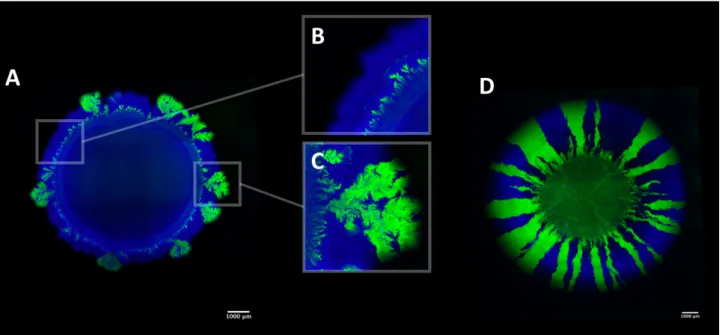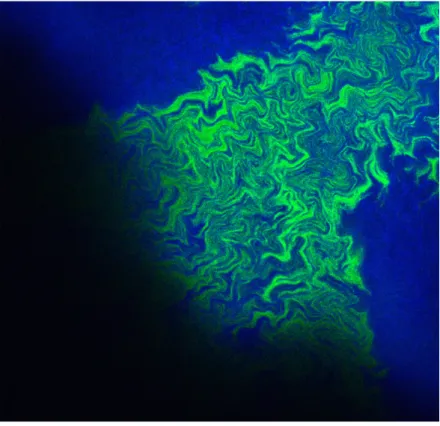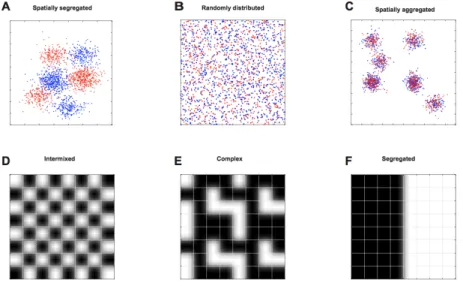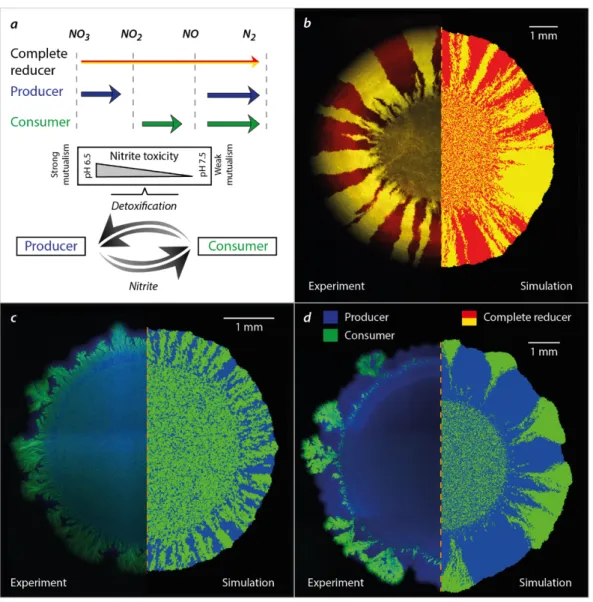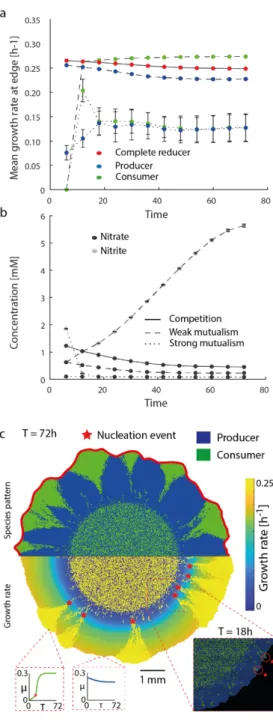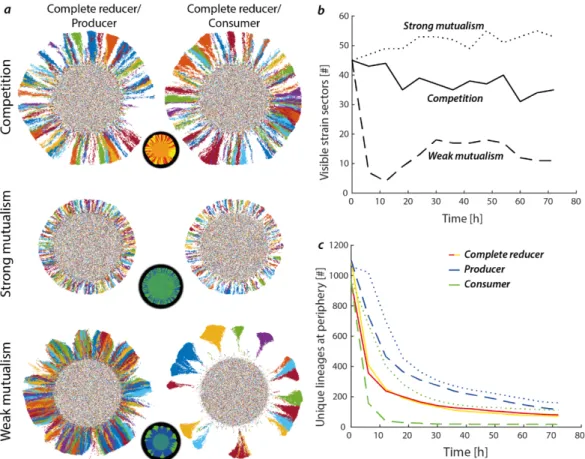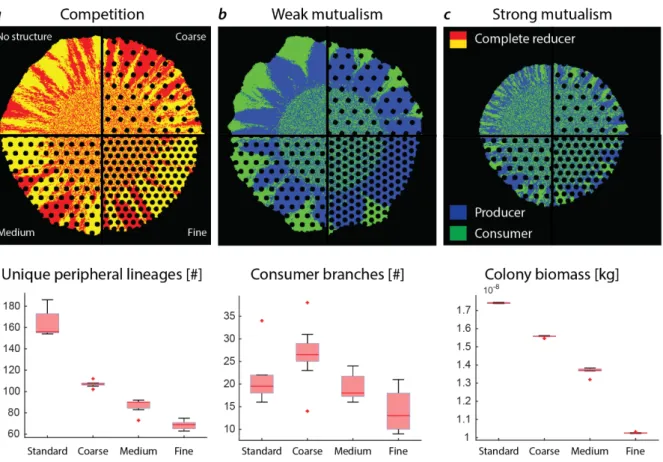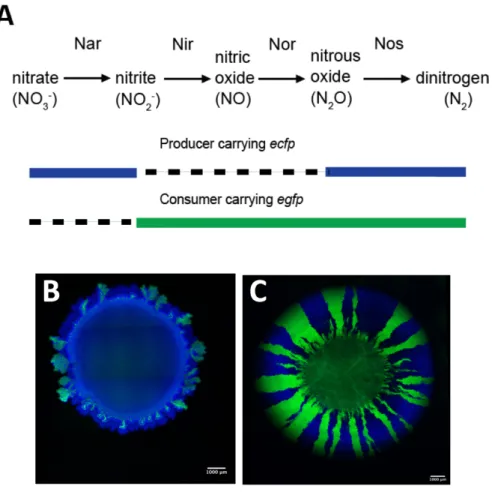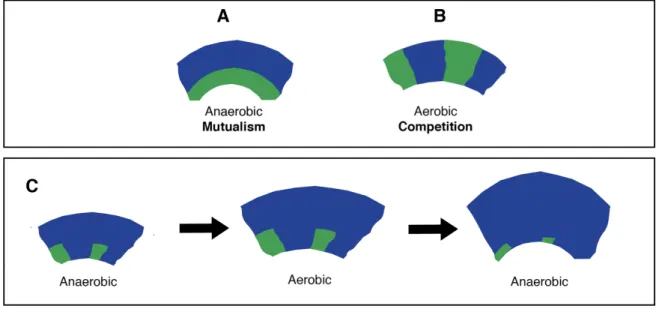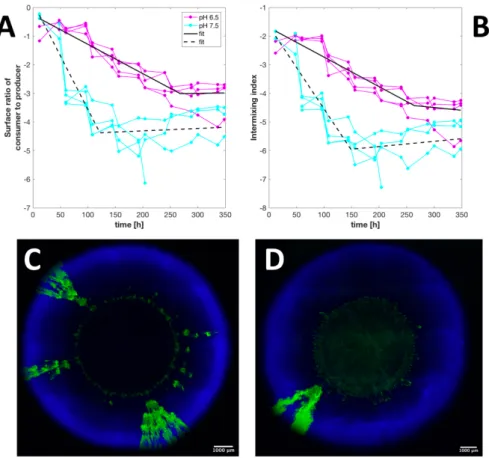Research Collection
Doctoral Thesis
Influence of temporal and spatial heterogeneity on microbial spatial self-organization
Author(s):
Ciccarese, Davide Publication Date:
2020-02
Permanent Link:
https://doi.org/10.3929/ethz-b-000401169
Rights / License:
In Copyright - Non-Commercial Use Permitted
This page was generated automatically upon download from the ETH Zurich Research Collection. For more information please consult the Terms of use.
Influence of temporal and spatial heterogeneity on microbial spatial self-organization.
Davide Ciccarese
DISS. ETH NO. 26644
DISS. ETH NO. 26644
Influence of temporal and spatial heterogeneity on microbial spatial self-organization.
A thesis submitted to attain the degree of DOCTOR OF SCIENCES of ETH ZURICH
(Dr. sc. ETH Zurich)
presented by Davide Ciccarese
MSc, University of Milan
born on 08.03.1983 citizen of
Italy
accepted on the recommendation of
Prof. Dani Or Examiner
Prof. Jan Roelof van der Meer Co-examiner
Dr David R. Johnson Co-examiner
Dedicated to Sara
Table of Contents
Summary 6
Sommario 8
1. Introduction 10
2. Functional microbial landscapes 26
3. The right place at the right time – environmental feedbacks favor a few lucky individuals for proliferation during bacterial range expansion
51
4. Spatial jackpot events enable community persistence during fluctuations between mutualism and competition.
75
5. Interaction-dependent effects of surface structure on the spatial self-organization of microbial communities.
101
6. The strength of a metabolic interaction determines the establishment, proliferation, and spatial organization of local microbial populations
133
7. Discussion and outlook 152
Acknowledgements 165
Curriculum vitae 168
SUMMARY
In this thesis work, I investigated the influences of environmental heterogeneities on the spatial self-organization of microbial communities. I took a reductionist approach using isogenic cross feeding strains grown under controlled environmental conditions. The environmental heterogeneities investigated in this research study include local nutrient availability, temporal fluctuations in environmental conditions, physical structures, and spatial distance between interacting individuals. In Chapter 1, I describe the main knowledge gaps regarding spatiotemporal heterogeneities as drivers of microbial spatial organization and community composition. In Chapter 2, I review the methods and current state of research in synthetic ecology to investigate the causes and consequences of microbial spatial self-organization. I described the properties of patterns of self-organization and propose methods to quantify them. Finally, I give an overview on the existing methods to engineer the spatial organization of microbial communities. In Chapter 3, I co-authored a research article on the influence of local nutrient concentrations on spatial organization and the maintenance of diversity during expansion of a cross-feeding community. I provided an agent-based model developed by Benedict Borer (ETHZ, STEP) that describes the influence of spatial organization on the reproductive success of lineages with consequences on the maintenance of genetic diversity during range expansion. I contributed to the experimental results, to the formulation of the main research question, and to the writing of the manuscript. In Chapter 4, I investigate patterns of spatial self-organization that emerge during range expansion of a cross feeding community under temporal fluctuations in the available electron acceptor. I used an updated version of the model presented in Chapter 3 to explain the mechanisms that enable the persistence of the community during fluctuating conditions and preserve genetic diversity. In Chapter 5, I describe how physical objects on a surface influence spatial self-organization and interspecific diversity during range expansion. I found that physical objects have differing effects depending on the types of interactions (competition and mutualism) present between genotypes. More specifically, I found that competitive interactions maintain higher diversity at the expanding edge compared to mutualistic interactions. In Chapter 6, I illustrate how the strength of a mutualistic interaction determines whether individuals are likely to develop into colonies. More specifically, I show that colony abundance, size and interspecific distance all depend on the strength of the interaction. I found that the mutualistic component of the net interaction determines the number of colonies and interspecific distances while the competitive component of the net interaction determines colony
size. In Chapter 7, I discuss the main outcome of the research work and I describe new direction of future investigations.
SOMMARIO
In questo lavoro di ricerca ho investigato le influenze delle eterogeneità ambientali sull’organizzazione delle comunità microbiche. Mi sono servito di un approccio riduzionistico usando mutanti isogenici con dipendenza trofica. Le eterogeneità ambientali investigate in questo lavoro di ricerca, sono rispettivamente: disponibilità di nutrienti locale, fluttuazioni temporali, strutture fisiche e interazioni a distanza tra individui. Nel capitolo 1, descrivo le lacune di conoscenza relative alle eterogeneità spazio-temporali che determinano l’emergere delle strutture batterica e che influenzano in fine la composizione comunitaria. Nel capitolo 2, illustro i metodi e lo stato attuale della ricerca dell'ecologia sintetica nello studio delle cause e conseguenze delle strutture batteriche. Ho descritto le proprietà degli strutture spaziali microbiche e ho proposto metodi per quantificare la loro disposizione spaziale. Infine, fornisco una panoramica dei metodi attualmente esistenti per ingegnerizzare le comunità microbiche. Nel capitolo 3, descrivo un lavoro di ricerca di cui sono stato coautore per studiare l'influenza della concentrazione locale di nutrienti sulla organizzazione microbica spaziale e sulle linee genetiche intraspecifiche durante l’espansione di comunità batteriche trofiche. Ho fornito un modello matematico basato sull’agente, sviluppato da Benedict Borer (ETHZ, STEP) capace di descrivere l'influenza delle strutture batteriche sul successo riproduttivo della diversità intraspecifica con conseguenze sulla deriva genetica nelle comunità in espansione. Ho contribuito ai risultati sperimentali, alla formulazione della domanda di ricerca principale e alla stesura del manoscritto. Nel capitolo 4 indago l'auto-organizzazione spaziale che emerge durante l’espansione delle comunità trofiche in condizioni atmosferiche fluttuanti. Ho usato una versione aggiornata del modello presentato nel capitolo 3 per spiegare i meccanismi che consentono la persistenza delle strutture batteriche capaci di preservare la diversità genetica in condizioni fluttuanti. Nel capitolo 5, descrivo come gli oggetti fisici su una superficie influenzano la diversità interspecifica nelle comunità in espansione. Diversi tipi di interazione (competizione e mutualismo) subiscono una diversa diminuzione della diversità genetica in presenza di oggetti fisici.
Ho potuto osservare che le interazioni competitive mantengono una maggiore diversità ai margini in espansione rispetto alle interazioni mutualistiche. Nel capitolo 6, illustro il successo della colonizzazione come conseguenza della intensità delle interazioni trofiche. In questo capitolo, mostro che il numero relativo delle colonie dipende dall'interazione trofica a livello di comunità.
Mentre a livello locale, l'interazione tra colonie vicine si dimostra essere una competizione di tipo
intraspecifica e interspecifica. Nel capitolo 7, discuto il risultato principale del lavoro di ricerca e ne descrivo gli sviluppi futuri.
CHAPTER 1: Introduction
Microbial spatial self-organization
Life on Earth is sustained by biogeochemical cycles powered by microbial communities [1–7]. One general feature that characterizes these communities is their incredibly biodiversity, and several mechanisms enable the coexistence of multiple genotypes [1, 8–13]. For example, different genotypes may perform different steps of the metabolic pathways (i.e., division of metabolic labor) that contribute to these biogeochemical cycles [14–18]. The metabolically specialized genotypes can then occupy different niches and thus avoid competition [19, 20]. Genotypes could also change their surrounding environment (niche construction) creating favorable conditions for [21] or conversely leading to deleterious effects on other genotypes [22]. Because the vast majority of microbial life is found in spatially structured microbial communities (defined as surface attached communities) all of the above mechanisms could occur [1, 23, 24]. Living in densely packed communities results in inevitable interactions with other genotype, and these interactions may dictate the metabolic strategy that one genotype has evolved [11, 12, 25–30].
Eventually, interactions between different genotypes on a surface will result in the emergence of non-random patterns referred to as spatial self-organization [31, 32]. These spatial patterns will influence the evolutionary processes acting on and the ecological processes performed by the communities themselves [33–36]. Therefore, it is fundamental to understand the mechanisms that promote spatial self-organization in order to understand the functioning and behaviors of microbial communities. Yet, there is still a lack of understanding on how spatial self-organization emerges in the first place. Furthermore, there is a lack of knowledge regarding the mechanisms that promote the emergence of spatial self-organization and the effects of spatial self-organization on ecological processes. This knowledge gap limits our ability to understand microbial communities outside of laboratory conditions where multispecies interactions create complex spatial structures and challenge the interpretation of their functionality [37]. In Chapter 2, I review the methods and research that has been conducted to explore the spatial self-organization of microbial communities.
The emergence of microbial spatial self-organization leads the community to reach a functionality that depends on the genotypic assemblage and their local interactions with each other [38, 39]. The actual microbial spatial structures enable different genotypes to specialize at different steps of metabolic pathways that are otherwise impermissible [40]. Therefore, when the genotypes are assembled together, they form specific microbial landscape with new capabilities [41, 42].
Within microbial communities, interactions between genotypes can be so important that very often many genotypes cannot be cultivated alone because they required other genotypes to produce essential biosynthetic building blocks [43, 44]. In fact, the collective properties of a microbial community are typically greater than the sum of properties of the individual genotypes [45]. These properties are often referred to as emergent properties [45, 46]. However, the interplay between different genotypes is also mediated by the environment [22, 47]. Microbial populations create intimate connections with the surrounding environment that are often difficult to separate completely [47, 48], to the point that isolating single species from their original environment becomes impossible [49, 50]. Therefore, it is the interplay between biotic and abiotic factors that determine the composition of microbial communities [34, 51–55]. Yet, one great knowledge gap is to understand how biotic and abiotic factors contribute to the development of spatial self- organization of microbial communities [37, 42, 56].
To fill this knowledge gap, I took a reductionist approach where I used an experimental model system to explore how metabolic interactions between two isogenic cross-feeding mutants affect spatial self-organization under controlled environmental conditions. In my research, I identified four main aspects that describe environmental heterogeneity: local nutrient availability, temporal fluctuations in environmental conditions, physical structures, and spatial distance between interacting individuals [15, 57]. I independently investigated how each of these parameters influence spatial self-organization using a synthetic cross feeding community as model system.
The model system is based on the bacterium Pseudomonas stutzeri A1501, which is a facultative anaerobic denitrifier [58]. The isogenic mutants were constructed by deleting gene clusters that encode for different steps of the denitrification pathway [59]. By deleting the nir gene cluster, one isogenic mutant is unable to reduce nitrite (NO2- ) to nitric oxide (NO), and I refer to this strain throughout the dissertation as the producer (i.e., it produces NO2- from the reduction of NO3-) [59–
61]. By deleting the nar gene cluster, a second isogenic mutant is unable to reduce nitrate (NO3- ) to nitrite (NO2-), and I refer to this strain throughout the dissertation as the consumer (i.e., it consumes
the NO2- produced by the producer) (52–54). In addition, by also using a completely reducing strain that reduces nitrate to nitrogen gas, I can study competitive interactions under anaerobic conditions [62]. The three strains carry different fluorescent protein-encoding genes (egfp or ecfp) thus enabling me to distinguish them under the microscope and study their spatial arrangement [60, 61].
Our model system enables me to explore a variety of interactions (Fig. 1). When the producer and consumer are mixed to an equal ratio and deposited on an agar plate as described elsewhere [63], the bacterial cells expand and arrange themselves in space. Under anaerobic conditions, the two strains engage in a nitrite (NO2-) cross-feeding interaction [63, 64]. During expansion when nitrate (NO3-) is provided as the growth limiting substrate, the producer and consumer will expand sequentially (Fig. 1A and B) where the producer grows ahead of the consumer (Fig. 1C). Yet, the consumer could reach the edge of the expanding colony due to initial spatial positioning (Fig. 1C).
The model system has an additional feature at pH 6.5, where nitrite (NO2-) becomes toxic [59], thus increasing the strength of the interaction between the producer and consumer. Conversely at pH 7.5 nitrite (NO2-) is less toxic, thus decreasing the strength of the interaction between the producer and consumer. Under aerobic conditions, the producer and consumer are metabolically independent and compete for oxygen. They consequently expand parallel to the axis of range expansion and form segregated sectors (Fig. 1D). The same pattern formation emerges if instead one would use two differently fluorescently tagged complete reducers (Fig. 1D). In Chapters 3, 4, 5 and 6, I investigate and discuss the ecological consequences of these different patterns of spatial self-organization.
Figure 1. Patterns of spatial self-organization produced by our model system. A) Under anaerobic conditions when nitrate (NO3-) is provided as the growth-limiting substrate, the producer (expressing the cyan fluorescent protein) and the consumer (expressing the green fluorescent protein) grow sequentially (close-up picture B). However, in some area of the expansion, the consumer can reach the expanding edge due to initial spatial positioning of the consumer cells (close-up picture C). D) Under aerobic conditions, the producer (expressing the cyan fluorescent protein) and consumer (expressing the green fluorescent protein) grow simultaneously and create segregative sectors. The same pattern formation emerges when using two complete reducers.
Main knowledge gaps
Below I identify four main knowledge gaps regarding the causes and consequences of microbial spatial self-organization. All four knowledge gaps can be addressed using the experimental model system described above and serve as the motivation for my four research chapters.
Spatial self-organization mediated by local environmental feedbacks
Any sessile microbial community is intimately connected with its with their surrounding environment [47, 65]. Individual cells change their surrounding environment and create optimal conditions to proliferate [47]. In dense communities, these local interactions enable the spatial structuring and persistence of genotypes [66]. However, any sessile microbial assemblage poses great challenges to investigating how individual genotypes contribute to the maintenance of community diversity.
In the third chapter, I present how local nutrient concentrations influence pattern formation and genetic diversity using a mathematical model developed by Benedict Borer (ETHZ, STEP). In our cross-feeding model system (described above), the emergence of dendritic-like structures of the consumer enable their local population to remain at the edge of the colony (Fig. 1C). The emergence of these structure is favored by an initial spatial positioning of the consumer at the expanding edge.
However, these structures seem to be an exception during successive expansion, and I therefore define them as spatial jackpot events in line with previous studies [67]. The mathematical model is able to describe how the metabolic interaction changes the local environment, creating heterogenous distributions of metabolites that influence spatial self-organization and population genetics. The model is then able to link the influence of jackpot events on the reproductive success of intraspecific lineages [68]. This result gives a better understanding of the interplay between spatial self-organization and population dynamics. More importantly, the model describes the intimate connection that spatial self-organization creates with the surrounding environment. Thus, suggesting a mechanism of growth rate differences due to heterogeneous local nutrient concentration within the expanding populations that drives the emergence of pattern formation.
Effects of spatial self-organization on community stability
The ecological stability of microbial communities is important in order to maintain its functioning over time [69]. However, periodic or sporadic changes in local environmental conditions pose a continuous challenge to this stability [70–73]. What are the mechanisms that prevent an ecosystem from collapsing in the face of these environmental changes? Does microbial spatial self-organization have a role in maintaining community stability over time?
The fourth chapter addresses this knowledge gap and builds upon to the previous one, as it investigates the emergence of the same pattern formation (spatial jackpot events) during temporal fluctuations in environmental conditions. The investigation of this specific heterogeneity is fundamental since every microbial community experiences fluctuating conditions that may affect community assembly [74, 75] and in turns their local spatial arrangement. It is then unclear how microbial spatial self-organization helps to maintain their ecological functionality under dynamically changing environmental conditions.
I wanted to fill this knowledge gap using our cross-feeding consortium to study the influence of temporal fluctuations on spatial self-organization. Specifically, our model system enables us to study changes in pattern formation as a response to fluctuating conditions (Fig.1). When the two isogenic cross-feeding mutants are exposed to anerobic conditions, they expand successively (positive interactions) (Fig.1B). In contrast, when they are incubated in aerobic conditions, they become metabolically independent, enabling the emergence of simultaneous expansion patterns (negative interactions Fig. 1C). The underlying hypothesis is that such a change between two different spatial organizations can compromise the cross-feeding community over time. In the fourth chapter, I show that the cross feeding system is maintained over time as a consequence of the emergence and persistence of jackpot events. Moreover, I tested two different strengths of interactions. I found that the persistence of jackpot events increased as the strength of the interaction increased. This chapter sheds new light on how spatial self-organization helps to maintain the stability of trophic dependent microbial assembly during temporal fluctuation.
Effects of physical objects on spatial self-organization
The emergence of spatial self-organization in microbial communities is determined in part by abiotic factors [76]. In particular, in the natural environment spatial geometry can influence species distributions and community assembly [36, 77–83]. Any population that lives attached to a surface will inevitably undergo range expansion [1, 11, 84]. Therefore, the presence of physical structures on a surface can be a potentially important determinant of microbial spatial organization [85–89].
How does geometric heterogeneity influence microbial spatial arrangement during range expansion?
I addressed this question in Chapter 5 by comparing the effects of physical objects on spatial self- organization for two different types of interactions. More specifically, I determined the effects of physical objects for negative interactions (competitive interaction) between two complete reducers and positive interactions (mutualistic interactions) between the producer and consumer. I postulated that physical objects create deformities at the expanding edge, which in turn affects spatial self-organization [88]. Such deformations at the expansion edge would not only affect spatial self-organization and ecosystem functioning, but also population dynamics [88, 90]. This is novel, as previous studies of the influence of physical objects was only investigated for competitive interactions [88, 91], and thus did not consider trophic interactions. Comparing these different interactions is important, as the spatial arrangements of competing and metabolically dependent species can be fundamentally different [61, 92].
I extended this work in Chapter 5 to investigate how the presence of physical objects affects diversity at the expansion edge. I found that, geometric heterogeneity has a smaller impact on interspecific diversity for the negative interaction (competition) than for the cross-feeding interactions (mutualism). This chapter shows how geometric heterogeneity shapes interspecific diversity along expansion edges and highlights that the type of interaction is a key determinant to affecting community diversity during range expansion.
Effects of initial spatial positioning on spatial self-organization
When a population establishes on a new surface, the initial spatial positioning of individuals can determine individual fate and success at colonizing the new surface [93, 94]. For example, when two metabolically dependent strains are separated by space, the interactions between individuals are determined by the diffusion of exchanged metabolites [47, 95]. Therefore, the initial spatial positioning is particularly important for the success of trophically interacting strains that rely on metabolite diffusion [39, 47, 65, 96]. The local densities of individuals, for instance, affect the gradient of the metabolites [34, 77]. However, it is the initial positioning of individuals that modulate the resource allocation between individuals [65]. The spatial distribution of species depends on their local interactions influencing the overall community properties [65, 97]. The emergence of colonies and their establishment in pure competitive scenario has been showed to be a territorial competition for space where the winning genotype outcompete the others maximizing its spatial coverage to access to the resource [93]. Yet, when two strains compete, the distances between colonies is determined by the type of competing species and nutrient source [96].
In Chapter 6, I studied the effect of local interactions and community composition (colonization success) comparing strong and weak mutualism. This chapter shows that the final composition of a community depends on different types of interactions that act locally to define the spatial distances (competition) and globally to determine the final number of individuals that compose a community (mutualism).
Thesis outline
In Chapter 2, I provide a review on the state of knowledge regarding microbial spatial self- organization, including an overview of approaches to study spatial self-organization under laboratory conditions. I describe several synthetic ecology approaches that try to fill the knowledge gap on how the spatial self-organization influences community functioning, ecology, and evolution.
In Chapter 3, I applied an agent-based model developed by Benedict Borer (ETHZ, STEP) to elucidate mechanisms that drive spatial self-organization in light of different trophic interactions.
Furthermore, this study provides an explanation for how localized growth rate differences rooted in the underlying nutrient landscape promote the emergence of different patterns that influence the genetic diversity.
In Chapter 4, I show how spatial self-organization enables community persistence in the face of fluctuating environmental conditions. I further describe a potential mechanism for how self- organization bestows the observed stability.
In Chapter 5, I report how geometric heterogeneity influences the emergence of spatial patterns during mutualistic and competitive interactions. I show how physical objects can modulate spatial self-organization and, in turn, population diversity. I found that the type of interaction is a key determinant of interspecific diversity in presence of physical objects.
In Chapter 6, I present how the community composition is affected by the interplay between initial spatial positioning of individuals and local interactions. I found that the final community composition is determined by mutualistic interactions at the community level but by competition at the local level.
In Chapter 7, I discuss the main outcomes of the dissertation and provide an outlook that emerges from the collective body of my work. I identify key areas for future investigation and propose approaches to address these new areas of research. I finally discuss how my research outcomes may be generalizable to other types of microbial communities.
REFERENCES
1. Flemming HC, Wuertz S. Bacteria and archaea on Earth and their abundance in biofilms. Nat Rev Microbiol 2019; 17: 247–260.
2. Lloyd KG, Steen AD, Ladau J, Yin J, Crosby L. Phylogenetically Novel Uncultured Microbial Cells Dominate Earth Microbiomes. mSystems 2018; 3:pii: e00055-18
3. L.R. T, J.G. S, D. M, A. A, J. L, K.J. L, et al. A communal catalogue reveals Earth’s multiscale microbial diversity. Nature 2017; 551:457-463
4. Whitman WB, Coleman DC, Wiebe WJ. Prokaryotes: The unseen majority. Proc Natl Acad Sci U S A . 1998; 95:6578-83
5. Locey KJ, Lennon JT. Scaling laws predict global microbial diversity. Proc Natl Acad Sci U S A 2016; 113:5970-5.
6. Venter JC, Remington K, Heidelberg JF, Halpern AL, Rusch D, Eisen JA, et al. Environmental Genome Shotgun Sequencing of the Sargasso Sea. Science (80- ) 2004; 304:66-74
7. Planet of the microorganisms. Nat Rev Microbiol 2018; 16: 257–257.
8. van Gestel J, Kolter R. When We Stop Thinking about Microbes as Cells. J Mol Biol . 2019;
431:2487-2492
9. Nadell CD, Xavier JB, Foster KR. The sociobiology of biofilms. FEMS Microbiol Rev 2009; 33:
206–224.
10. Mitri S, Xavier JB, Foster KR. Social evolution in multispecies biofilms. Proc Natl Acad Sci 2011;
108: 10839–10846.
11. Mitri S, Richard Foster K. The Genotypic View of Social Interactions in Microbial Communities.
Annu Rev Genet 2013; 47: 247–273.
12. Crespi BJ. The evolution of social behavior in microorganisms. Trends Ecol Evol . 2001; 16:178- 183.
13. Foster KR. A defense of sociobiology. Cold Spring Harb. Symp. Quant. Biol. 2009; 74:403-18 14. Ackermann M. A functional perspective on phenotypic heterogeneity in microorganisms. Nat
Rev Microbiol 2015; 13: 497–508.
15. Stubbendieck RM, Vargas-Bautista C, Straight PD. Bacterial communities: Interactions to scale. Front Microbiol 2016; 7: 1–19.
16. Ponomarova O, Patil KR. Metabolic interactions in microbial communities: Untangling the Gordian knot. Curr Opin Microbiol 2015; 27: 37–44.
17. Johnson DR, Goldschmidt F, Lilja EE, Ackermann M. Metabolic specialization and the assembly of microbial communities. ISME J . 2012; 6:1985-91
18. Dolinšek J, Goldschmidt F, Johnson DR. Synthetic microbial ecology and the dynamic interplay between microbial genotypes. FEMS Microbiol Rev 2016; 40: 961–979.
19. Archidona-Yuste A, Wiegand T, Castillo P, Navas-Cortés JA. Spatial structure and soil properties shape local community structure of plant-parasitic nematodes in cultivated olive trees in southern Spain. Agric Ecosyst Environ 2020; 27:104658
20. Peipoch M, Miller SR, Antao TR, Valett HM. Niche partitioning of microbial communities in riverine floodplains. Sci Rep 2019; 9:16384
21. Herschend J, Koren K, Røder HL, Brejnrod A, Kühl M, Burmølle M. In Vitro Community Synergy between Bacterial Soil Isolates Can Be Facilitated by pH Stabilization of the Environment . Appl Environ Microbiol 2018; 84: 1–15.
22. Ratzke C, Denk J, Gore J. Ecological suicide in microbes. Nat Ecol Evol 2018; 2: 867–872.
23. Flemming H-C, Wingender J, Szewzyk U, Steinberg P, Rice SA, Kjelleberg S. Biofilms: an emergent form of bacterial life. Nat Rev Microbiol 2016; 14: 563–575.
24. Flemming HC, Wingender J. The biofilm matrix. Nat Rev Microbiol . 2010; 8:623-33
25. Hallatschek O, Hersen P, Ramanathan S, Nelson DR. Genetic drift at expanding frontiers promotes gene segregation. Proc Natl Acad Sci 2007; 104: 19926–19930.
26. Van Gestel J, Weissing FJ, Kuipers OP, Kovács ÁT. Density of founder cells affects spatial pattern formation and cooperation in Bacillus subtilis biofilms. ISME J 2014; 8: 2069–2079.
27. Muller MJI, Neugeboren BI, Nelson DR, Murray AW. Genetic drift opposes mutualism during spatial population expansion. Proc Natl Acad Sci 2014; 111: 1037–1042.
28. Mitri S, Clarke E, Foster KR. Resource limitation drives spatial organization in microbial groups. ISME J 2016; 10: 1471–1482.
29. Nadell CD, Drescher K, Foster KR. Spatial structure, cooperation and competition in biofilms.
Nat Rev Microbiol 2016; 14: 589–600.
30. McNally L, Bernardy E, Thomas J, Kalziqi A, Pentz J, Brown SP, et al. Killing by Type VI secretion drives genetic phase separation and correlates with increased cooperation. Nat Commun 2017; 8: 14371.
31. Rietkerk M, van de Koppel J. Regular pattern formation in real ecosystems. Trends Ecol Evol 2008; 23: 169–175.
32. Pringle RM, Tarnita CE. Spatial Self-Organization of Ecosystems: Integrating Multiple
Mechanisms of Regular-Pattern Formation. Annu Rev Entomol 2017; 62:359-377
33. Kim W, Racimo F, Schluter J, Levy SB, Foster KR. Importance of positioning for microbial evolution. Proc Natl Acad Sci U S A 2014; 111: E1639-47.
34. Cordero OX, Datta MS. Microbial interactions and community assembly at microscales. Curr Opin Microbiol . 2016; 31:227-234
35. Estrela S, Brown SP. Community interactions and spatial structure shape selection on antibiotic resistant lineages. PLOS Comput Biol 2018; 14: e1006179.
36. Neu L, Proctor CR, Walser J-C, Hammes F. Small-Scale Heterogeneity in Drinking Water Biofilms. Front Microbiol 2019; 10: 2446.
37. Tecon R, Mitri S, Ciccarese D, Or D, van der Meer JR, Johnson DR. Bridging the Holistic- Reductionist Divide in Microbial Ecology. mSystems 2019; 4: e00265-18
38. Bottery MJ, Passaris I, Dytham C, Wood AJ, van der Woude MW. Spatial Organization of Expanding Bacterial Colonies Is Affected by Contact-Dependent Growth Inhibition. Curr Biol 2019; 29:3622-3634
39. Nadell CD, Drescher K, Foster KR. Spatial structure, cooperation and competition in biofilms.
Nat Rev Microbiol 2016; 14: 589–600.
40. Zerfaß C, Chen J, Soyer OS. Engineering microbial communities using thermodynamic principles and electrical interfaces. Curr Opin Biotechnol . 2018; 50:121-127
41. Madsen JS, Sørensen SJ, Burmølle M. Bacterial social interactions and the emergence of community-intrinsic properties. Curr Opin Microbiol . 2018. Elsevier Ltd. , 42: 104–109 42. Ciccarese D, Johnson DR. Functional Microbial Landscapes. Compr Biotechnol 2019; 42–51.
43. Stewart EJ. Growing unculturable bacteria. J Bacteriol . 2012; 94:4151-60
44. Puspita ID, Kamagata Y, Tanaka M, Asano K, Nakatsu CH. Are uncultivated bacteria really uncultivable? Microbes Environ . 2012. 27: 356–366
45. Nadell CD, Foster KR, Xavier JB. Emergence of spatial structure in cell groups and the evolution of cooperation. PLoS Comput Biol 2010; 6: e1000716
46. Flemming HC, Wingender J, Szewzyk U, Steinberg P, Rice SA, Kjelleberg S. Biofilms: An emergent form of bacterial life. Nat Rev Microbiol . 2016; 14:563-75
47. Estrela S, Libby E, Van Cleve J, Débarre F, Deforet M, Harcombe WR, et al. Environmentally Mediated Social Dilemmas. Trends Ecol Evol 2019; 34: 6–18.
48. Odling-Smee FJ, Laland KN, Feldman MW. Niche construction: The neglected process in evolution. Princeton University Press . 2013; 30: 191–202
49. Pham VHT, Kim J. Cultivation of unculturable soil bacteria. Trends Biotechnol . 2012; 30:475- 84
50. Ferrari BC, Binnerup SJ, Gillings M. Microcolony cultivation on a soil substrate membrane system selects for previously uncultured soil bacteria. Appl Environ Microbiol 2005; 71:8714- 20
51. Lee CK, Laughlin DC, Bottos EM, Caruso T, Joy K, Barrett JE, et al. Biotic interactions are an unexpected yet critical control on the complexity of an abiotically driven polar ecosystem.
Commun Biol 2019; 2:62
52. Ebrahimi A, Schwartzman J, Cordero OX. Cooperation and spatial self-organization determine rate and efficiency of particulate organic matter degradation in marine bacteria. Proc Natl Acad Sci U S A 2019; 116: 23309–23316.
53. Wu X, Wang Y, Zhu Y, Tian H, Qin X, Cui C, et al. Variability in the Response of Bacterial Community Assembly to Environmental Selection and Biotic Factors Depends on the Immigrated Bacteria, as Revealed by a Soil Microcosm Experiment. mSystems 2019; 4:
e00496-19
54. Jiang X, Zerfaß C, Feng S, Eichmann R, Asally M, Schäfer P, et al. Impact of spatial organization on a novel auxotrophic interaction among soil microbes. ISME J 2018; 12:1443–1456
55. Kassen R. The experimental evolution of specialists, generalists, and the maintenance of diversity. J Evol Biol 2002; 15: 173–190.
56. Widder S, Allen RJ, Pfeiffer T, Curtis TP, Wiuf C, Sloan WT, et al. Challenges in microbial ecology: building predictive understanding of community function and dynamics. ISME J 2016; 10: 2557–2568.
57. Ramette A, Tiedje JM. Multiscale responses of microbial life to spatial distance and environmental heterogeneity in a patchy ecosystem. Proc Natl Acad Sci U S A 2007; 104:
2761–6.
58. Lalucat J, Bennasar A, Bosch R, Garcia-Valdes E, Palleroni NJ. Biology of Pseudomonas stutzeri.
Microbiol Mol Biol Rev 2006; 70: 510–547.
59. Lilja EE, Johnson DR. Metabolite toxicity determines the pace of molecular evolution within microbial populations. BMC Evol Biol 2017; 17: 1–12.
60. Goldschmidt F, Regoes RR, Johnson DR. Metabolite toxicity slows local diversity loss during expansion of a microbial cross-feeding community. ISME J 2018; 12: 136–144.
61. Goldschmidt F, Regoes RR, Johnson DR. Successive range expansion promotes diversity and
accelerates evolution in spatially structured microbial populations. ISME J 2017; 11:2112- 2123
62. Lilja EE, Johnson DR. Segregating metabolic processes into different microbial cells accelerates the consumption of inhibitory substrates. ISME J 2016; 10: 1568–1578.
63. Goldschmidt F, Regoes RR, Johnson DR. Successive range expansion promotes diversity and accelerates evolution in spatially structured microbial populations. ISME J 2017; 11: 2112–
2123.
64. Lilja EE, Johnson DR. Metabolite toxicity determines the pace of molecular evolution within microbial populations. BMC Evol Biol 2017; 17: 52.
65. Harcombe WR, Riehl WJ, Dukovski I, Granger BR, Betts A, Lang AH, et al. Metabolic resource allocation in individual microbes determines ecosystem interactions and spatial dynamics.
Cell Rep 2014; 7: 1104–1115.
66. Nadell CD, Drescher K, Foster KR. Spatial structure, cooperation and competition in biofilms.
Nat Rev Microbiol 2016; 14: 589–600.
67. Fusco D, Gralka M, Kayser J, Anderson A, Hallatschek O. Excess of mutational jackpot events in expanding populations revealed by spatial Luria-Delbrück experiments. Nat Commun 2016;
7:12760
68. Wright ES, Vetsigian KH. Stochastic exits from dormancy give rise to heavy-tailed distributions of descendants in bacterial populations. Mol Ecol 2019; 28:3915–3928
69. Li W, Stevens MHH. Community temporal variability increases with fluctuating resource availability. Sci Rep 2017; 7: 45280
70. Shenhav L, Furman O, Briscoe L, Thompson M, Silverman JD, Mizrahi I, et al. Modeling the temporal dynamics of the gut microbial community in adults and infants. PLoS Comput Biol 2019; 15: e1006960
71. Buscardo E, Geml J, Schmidt SK, Freitas H, Da Cunha HB, Nagy L. Spatio-temporal dynamics of soil bacterial communities as a function of Amazon forest phenology. Sci Rep 2018; 8:4382 72. Pett-Ridge J, Silver WL, Firestone MK. Redox fluctuations frame microbial community impacts
on N-cycling rates in a humid tropical forest soil. Biogeochemistry 2006; 81:95–110
73. Tecon R, Ebrahimi A, Kleyer H, Erev Levi S, Or D. Cell-to-cell bacterial interactions promoted by drier conditions on soil surfaces. Proc Natl Acad Sci 2018; 115: 9791–9796.
74. Rodríguez-Verdugo A, Vulin C, Ackermann M. The rate of environmental fluctuations shapes ecological dynamics in a two-species microbial system. Ecol Lett . 2019; 22:838-846
75. Doan HK, Leveau JHJ. Artificial Surfaces in Phyllosphere Microbiology. Phytopathology 2015;
105: 1036–1042.
76. Green JL, Bohannan BJM, Whitaker RJ. Microbial biogeography: from taxonomy to traits.
Science 2008; 320: 1039–43.
77. Datta MS, Sliwerska E, Gore J, Polz MF, Cordero OX. Microbial interactions lead to rapid micro-scale successions on model marine particles. Nat Commun 2016; 7:1196
78. Ettema CH, Wardle DA. Spatial soil ecology. Trends Ecol Evol . 2002; 17:177-183
79. Ramette A, Tiedje JM. Multiscale responses of microbial life to spatial distance and environmental heterogeneity in a patchy ecosystem. Proc Natl Acad Sci U S A 2007; 104:2761- 2766
80. Tecon R, Or D. Cooperation in carbon source degradation shapes spatial self-organization of microbial consortia on hydrated surfaces. Sci Rep 2017; 7: 1–11.
81. Borer B, Tecon R, Or D. Spatial organization of bacterial populations in response to oxygen and carbon counter-gradients in pore networks. Nat Commun 2018; 9:769
82. Enke TN, Leventhal GE, Metzger M, Saavedra JT, Cordero OX. Microscale ecology regulates particulate organic matter turnover in model marine microbial communities. Nat Commun 2018; 9:2743
83. Spiesman BJ, Stapper AP, Inouye BD. Patch size, isolation, and matrix effects on biodiversity and ecosystem functioning in a landscape microcosm. Ecosphere 2018; 9: e02173.
84. Branda SS, Vik Å, Friedman L, Kolter R. Biofilms: The matrix revisited. Trends Microbiol 2005;
13: 20–26.
85. Gralka M, Hallatschek O. Environmental heterogeneity can tip the population genetics of range expansions. Elife 2019; 8: 1–24.
86. Burton OJ, Travis JMJ. Landscape structure and boundary effects determine the fate of mutations occurring during range expansions. Heredity (Edinb) 2008; 101:329–340
87. Möbius W, Murray AW, Nelson DR. How Obstacles Perturb Population Fronts and Alter Their Genetic Structure. PLoS Comput Biol 2015; 11: 1–30.
88. Beller DA, Alards KMJ, Tesser F, Mosna RA, Toschi F, Möbius W. Evolution of populations expanding on curved surfaces(a). Epl 2018; 123:58005
89. Wang G, Or D. Trophic interactions induce spatial self-organization of microbial consortia on rough surfaces. Sci Rep 2014; 4:6757
90. Kayser J, Schreck CF, Gralka M, Fusco D, Hallatschek O. Collective motion conceals fitness
differences in crowded cellular populations. Nat Ecol Evol 2019; 3: 125–134.
91. Möbius W, Murray AW, Nelson DR. How Obstacles Perturb Population Fronts and Alter Their Genetic Structure. PLOS Comput Biol 2015; 11: e1004615.
92. Goldschmidt F, Regoes RR, Johnson DR. Metabolite toxicity slows local diversity loss during expansion of a microbial cross-feeding community. ISME J 2018; 12:136-144
93. P. LD, J. AR. Competition for space during bacterial colonization of a surface. J R Soc Interface 2015; 12: 20150608.
94. Chacón JM, Möbius W, Harcombe WR. The spatial and metabolic basis of colony size variation. ISME J 2018; 12: 669–680.
95. Ghoul M, Mitri S. The Ecology and Evolution of Microbial Competition. Trends Microbiol 2016;
24: 833–845.
96. Chacón JM, Möbius W, Harcombe WR. The spatial and metabolic basis of colony size variation. ISME J . 2018. , 12: 669–680
97. Kerr B., Riley M.A., Feldman M.W., Bohannan B.J.M. Local dispersal promotes biodiversity in a real-life game of rock-paper-scissors. Nature 2002; 418: 171–174.
CHAPTER 2: Functional Microbial Landscapes
A similar version of this chapter has been published as:
Ciccarese, Davide, & Johnson, R. David (2019). Functional microbial landscapes. In S. Agathos & B.
Stenuit (Eds.), Comprehensive biotechnology: Vol. 6. Environmental and related biotechnologies (pp. 42-51). Elsevier
ABSTRACT
Surface-attached microbial communities are omnipresent on our planet. They play an important role in all major biogeochemical processes, provide valuable services to human society and our environment, and are utilized for biotechnological applications. An important feature of surface- attached microbial communities is that different microbial genotypes are typically not distributed randomly in space. Instead, they are typically distributed non-randomly in space and can arrange themselves into fascinating and intriguing patterns (i.e., spatial self-organization). We refer to these non-random patterns of spatial self-organization as microbial landscapes. In this chapter, we first review the underlying causes of spatial self-organization and the emergence of microbial landscapes. We next describe how the emergence of a microbial landscape can affect the metabolic, ecological, and evolutionary properties and behaviors of microbial communities. We then provide an overview of how to quantitatively analyze microbial landscapes and discuss how such quantitative information can generate insights into the underlying causes and consequences of their emergence. We further discuss how laboratory experiments can inform us about the properties and behaviors of microbial landscapes in nature. Finally, we discuss how we might engineer microbial landscapes to achieve biotechnological objectives.
INTRODUCTION
An immense amount of microbial life on our planet exists in a spatially structured, sessile state attached to surfaces. One example is biofilms, where individual cells are embedded within an extracellular matrix or, in some cases, directly attached to neighboring cells [1, 2]. Surface-attached microbial communities can form on nearly every surface on our planet. This includes biotic surfaces, such as the human gastrointestinal tract [3] and plant roots [4], and abiotic surfaces, such as on soil particles [5], bioreactor components [6], industrial membranes [7], and water distribution pipes [8].
An important feature of surface-attached microbial communities is that cells are typically distributed non-randomly in space, resulting in higher-level functionalities and three-dimensional spatial organization. The formation of such non-random spatial distributions is referred to as spatial self-organization [9,10] and can result in the emergence of fascinating and intriguing spatial patterns [11-19] (Figure 1).
Figure 1. Spatial self-organization of a microbial community. This pattern emerges when two nitrite cross-feeding genotypes are supplied with nitrate as the growth-limiting substrate and expand together across a flat surface. The blue genotype contains a loss-of-function mutation in nitrite reductase and consumes nitrate but not nitrite. The green genotype contains a loss-of-function mutation in nitrate reductase and consumes nitrite but not nitrate. The two genotypes self-organize and produce fractal-like patterns during range expansion. The image is of the leading edge of community expansion and was obtained with confocal laser scanning microscopy.
What causes spatial self-organization to emerge across a surface? There are a multitude of potential causes, but they can broadly be delineated into abiotic and biotic determinants. Abiotic determinants include physical and chemical heterogeneities across the surface itself [20-23]. For example, patchy distributions of resources or local environmental conditions across the surface can cause different species to spatially aggregate together or segregate from each other more often than would be expected by chance, thus resulting in non-random distributions (Figure 2). Biotic determinants include interactions between different genotypes [11, 13, 14, 24]. Negative interactions (i.e., competition, antagonism, etc.) can cause the genotypes to spatially segregate from each other, while positive interactions between genotypes (i.e., mutualism, commensalism, etc.) can cause the genotypes to spatially aggregate together, both of which create non-random
spatial distributions (Figure 2). We refer to these non-random patterns of spatial self-organization as ‘microbial landscapes’ to emphasize this complexity, where a particular pattern of spatial self- organization may result from the abiotic conditions across the surface, the biotic properties of the resident genotypes, and interactions between those abiotic and biotic factors. Here, the concept of a microbial landscape is inspired from the central tenants of landscape ecology, which seeks to understand the reciprocal effects between patterns of spatial self-organization of ecological objects and the physical, chemical, and biological properties of the ecosystem [25].
Figure 2. Examples of patterns of spatial self-organization. Consider two different genotypes (marked red and blue). These two genotypes may organize in one of three different patterns. (A) The two genotypes are segregated from each other in space. (B) The two genotypes are randomly distributed in space. (C) The two genotypes are aggregated together in space. The patterns of the two genotypes may also display higher-order properties. (D) The two genotypes are intermixed with a checkerboard pattern. This represents the maximum amount of intermixing but low complexity.
(E) The two genotypes are intermixed with a complex pattern. The example is a self-similar fractal- like pattern with an intermediate amount of intermixing and high complexity. (F) The two genotypes are spatially segregated from each other with no intermixing and low complexity.
Properties of microbial landscapes
Why do we care about microbial landscapes? Importantly, a microbial landscape is not merely a fascinating pattern of spatial self-organization. Indeed, the microbial landscape itself can have profound effects on the properties and behaviors of the microbial community as a whole [2]. Below we summarize how the emergence of a microbial landscape can impact the metabolic, ecological, and evolutionary properties of a microbial community.
Metabolic properties
The emergence of a microbial landscape can enable metabolic processes that might otherwise be inefficient, unstable, or impermissible in a completely mixed environment, where microorganisms often exist in an spatially unstructured, planktonic state [26-28]. A canonical example is the enabling of metabolic pathways that would otherwise be thermodynamically unfavorable. Fermentation pathways involving interspecies electron transfer are one example [29]. Many fermentation pathways convert organic matter via the transfer of electrons to electron carriers, such as hydrogen.
If hydrogen accumulates to sufficient concentrations, however, the fermentation process may no longer be thermodynamically favorable, consequently slowing or even ceasing operation of the process [29]. To overcome this limitation, genotypes often assemble together and form microbial landscapes that mitigate this effect, where hydrogen-producing genotypes lie in close spatial proximity to hydrogen-consuming genotypes (i.e., spatial aggregation) [29]. The spatial aggregation of hydrogen-producing and -consuming genotypes maximizes the flux of hydrogen between them, thus minimizing the local accumulation of hydrogen and preventing the fermentation process from becoming thermodynamically unfavorable [29]. Another canonical example is the enabling of metabolic pathways that produce toxic intermediates. In investigations by Goldschmidt and coworkers [19, 30], a synthetic cross-feeding microbial community was engineered where one genotype metabolizes nitrate to nitrite while another genotype metabolizes the secreted nitrite.
One challenge of this pathway is that nitrite is conditionally toxic [31]. When the genotypes are grown together, they form a specific microbial landscape, where the nitrite producing and consuming genotypes lie in close spatial proximity to each other [19, 30]. This results in increased growth rates of the microbial community as a whole, likely because the spatial aggregation of the different genotypes prevents the accumulation of nitrite and reduces its toxic effects [19, 30].
There are numerous other examples of how the emergence of a microbial landscape can enable otherwise impermissible metabolic processes to occur [26-28]. The recurring theme of these studies is that many metabolic processes require the exchange of metabolites between different genotypes.
The emergence of microbial landscapes where the metabolite-exchanging genotypes lie in close spatial proximity to each other (i.e., spatial aggregation) enhances the exchange of metabolites between the genotypes and/or reduces the negative effects of accumulated metabolites.
Metabolite exchange thus represents a general mechanism by which the emergence of a microbial landscape can enable otherwise impermissible metabolic processes to occur.
Ecological properties
The emergence of a microbial landscape has strong relationships with the types of interactions that occur between different genotypes [11, 14, 16-18]. Importantly, interactions between different genotypes often depend on their spatial positioning to each other [11, 14, 16-18]. Two genotypes may interact positively (i.e., mutualism, commensalism, etc.) if they have one particular spatial positioning, but may interact negatively (i.e., competition, antagonism, etc.) if they have an alternative spatial positioning. This was elegantly illustrated with experiments conducted with two genotypes that cross-feed a metabolic intermediate. In those experiments, Acinetobacter strain C6 was assembled together with Pseudomonas putida strain R1 and the consortia was supplied with benzoyl alcohol as the growth-supporting substrate, where both strains can metabolize benzoyl alcohol via benzoate to CO2 [32]. When grown together in a chemostat culture in the absence of spatial structure, and thus the absence of a microbial landscape, the two strains competed with each other and the Acinetobacter strain eventually reached high frequencies and dominated the culture. When grown together in a spatially structured environment, however, a clear microbial landscape emerged that promoted a more commensal interaction [32]. The Acinetobacter strain primarily metabolized benzoyl alcohol to benzoate while the P. putida strain metabolized the released benzoate, thus enabling P. putida to reach higher frequencies. Thus, the interaction switches from largely negative (i.e., competition for benzoyl alcohol) to commensal (i.e., cross- feeding of benzoate) when spatial structure is present and permits the emergence of a microbial landscape [32].
Another example is that the emergence of a microbial landscape can promote cooperative behaviors between genotypes via the release of metabolic products that are subsequently utilized by other individuals (i.e., public goods). Extracellular polysaccharides (EPS), which are one of the most abundant components of the biofilm matrix, can be viewed as one of these public goods. While some individuals may divert metabolic resources from their own growth into producing and excreting EPS, other individuals may benefit from its release without investing their own resources into its production. In a study by van Gestel and coworkers [33], the authors tested whether EPS production is indeed a cooperative trait. Using mutant strains of Bacillus subtilis that differ in the production of EPS, the authors demonstrated that the microbial community as a whole benefits from the presence of mutant genotypes with higher levels of EPS production [33]. Moreover, they demonstrated that the initial relative abundance of different mutant genotypes (and thus different
levels of EPS production) affects the organization of the microbial landscape and other emergent properties of the microbial community [33].
The emergence of a microbial landscape can also have profound effect on the temporal stability of a microbial community. Namely, the small-scale spatial aggregation of different genotypes can stabilize their interactions over time [11, 14]. In a seminal study by Kerr and colleagues [11], the authors created a synthetic microbial community consisting of three genotypes of Escherichia coli:
one produces colicin (genotye C), one is sensitive to colicin (genotype S), and one is resistance to colicin (genotype R). When propagated in batch culture without spatial structure, only genotype R persists, where it first displaces genotype S and then outcompetes genotype C. Genotype S is displaced due to the production of colicin while genotype C is displaced due to the costs of carrying the colicin-encoding plasmid. When propagated on agar plates that impose spatial structure, however, all three genotypes co-exist and form a distinct microbial landscape, where the three types dynamically invade each other [11]. Genotype C invades genotype S, genotype S invades genotype R, and genotype R invades genotype C. Thus, spatial structure promotes the emergence of a microbial landscape that stabilizes local interactions and enables all three genotypes to co-exist.
Importantly, the example above illustrates that spatial structure and the emergence of a microbial landscape can be a powerful force that maintains biodiversity by stabilizing local interactions between different genotypes [11]. However, the emergence of a microbial landscape can maintain and promote biodiversity via a wide range of additional mechanisms. Among the most intuitive mechanisms is heterogeneity in the local environmental conditions across the landscape that can promote local niche partitioning. If environmental heterogeneity is present, then this heterogeneity can create discrete niche spaces across the landscape, where different specialized genotypes can occupy and persist within different types of niches [20, 21, 24].
Perhaps a less intuitive mechanism for how interactions can maintain biodiversity is the role of the interactions themselves as a microbial community expands across space (i.e., range expansion). In a seminal study by Hallatschek and coworkers [12], the authors constructed a synthetic microbial community consisting of two genotypes of E. coli that express different fluorescent proteins but are otherwise genetically identical. The two genotypes thus interact via pure competition. As the microbial community expands across space (i.e., range expansion), only a few individuals emigrate
from the founding zone and contribute to community expansion, reflecting a massive loss of genetic diversity that might be present within the founding zone [12]. In analogous studies by Goldschmidt and coworkers [19, 30], however, the authors engineered communities where the two genotypes interact via metabolite cross-feeding rather than by pure competition. The authors hypothesized that metabolite cross-feeding should promote intermixing between the two genotypes, thus enabling more individuals to emigrate from the founding zone and contribute towards community expansion. Because more individuals would emigrate from the founding zone, this would maintain more of the potential genetic diversity present within the founding zone. Indeed, this outcome was experimentally observed [19, 30]. Thus, interactions that promote the emergence of microbial landscapes with increased intermixing also maintain more genetic diversity as a microbial community expands across space [18, 19, 30].
Finally, the emergence of a microbial landscape can have profound effects on the resistance and resilience of a microbial community to external perturbations. Antibiotic resistance bestowed by extracellular enzymes provides one illustrative example [34]. Assemblages of antibiotic resistant and non-resistant genotypes can co-exist in a spatially structured environment and collectively resist the negative impacts of antibiotic administration [34]. Briefly, when resistant and non-resistant genotypes are grown together in the absence of spatial structure, the resistant genotype displaces the non-resistant genotype after administration of antibiotics. However, when the resistant and non-resistant genotypes arrange themselves into a microbial landscape in a spatially structured environment, the microbial community as a whole can persist after administration of antibiotics.
This is because the two genotypes aggregate together in space, and the resistant genotype produces sufficient local concentrations of the extracellular enzyme to confer resistance to the non-resistant genotype. The microbial community can exhibit improved growth as a whole when compared to either genotype growing in isolation, which may result from intrinsic tradeoffs between resistance and growth properties. The non-resistant genotype has improved growth performance because it does not pay the costs for resistance, which manifests into improved growth of the microbial community as a whole when the resistant genotype provides resistance to the non-resistant genotype. However, this effect only occurs when the genotypes grow in a spatially structured environment and form a microbial landscape that results in the spatial aggregation of the two genotypes, thus permitting the extracellular enzyme to accumulate to sufficiently high local concentrations to confer community-level resistance [34].
Evolutionary properties
The emergence of a microbial landscape can also affect the pace of molecular evolution within microbial communities [30, 35, 36]. In a study by Goldschmidt and coworkers [30], the authors found that certain types of microbial landscapes accelerate the pace of molecular evolution. The authors imposed a substrate cross-feeding interaction between two microbial genotypes that promote intermixing between the genotypes. The consequence of intermixing is that each genotype population fragments across space to form smaller local population sizes [30]. Because the local population sizes are smaller, beneficial mutations are more likely to establish within those smaller local populations. The consequence is that the pace of molecular evolution accelerates [30]. This principle is not unique to the substrate cross-feeding interaction imposed by the authors. Instead, it should be generalizable to any interaction or process that promotes the emergence of microbial landscapes where a larger population is spatially fragmented into smaller local population sizes.
Other types of microbial landscapes may decrease the pace of molecular evolution. In the seminal study reported by Hallatschek and coworkers [12], the authors demonstrated that only a few individuals located at the leading edge of an expanding microbial community contribute towards the production of new biomass as the microbial community expands across space (i.e., range expansion). This has an important consequence on molecular evolution. If a beneficial mutation were to emerge behind the leading edge of expansion, it may not be able to establish even though it is beneficial. This is because the benefits of the mutation may not outweigh the unfavorable spatial positioning of the recipient individuals that lie behind the leading edge of expansion, where resources are less available. In other words, the probability that a beneficial mutation will establish depends not only on the benefits of the mutation itself, but also on the spatial arrangement of individuals across the microbial landscape.
Finally, the emergence of a microbial landscape may enable deleterious evolutionary trajectories as a microbial community expands across space (i.e., range expansion) [37, 38]. The fundamental idea here is again that only a few individuals located at the front of an expanding microbial community contribute towards the production of new biomass. If one of those individuals contains a deleterious mutation, it may nevertheless establish within the microbial community. This is because the benefits of its favorable spatial positioning at the leading edge of expansion where resources are abundant
may outweigh the deleterious effects of the mutation itself. This has been referred to as “genetic surfing” and is a potentially generalizable mechanism for how deleterious mutations may spread across space and reach high frequencies [39, 40]. For example, it has been proposed as a mechanism for how deleterious mutations might have accumulated within human populations as they expanded across the planet [39, 41].
Quantifying microbial landscapes
Quantifying features of microbial landscapes is often a central task for many investigations.
Quantification enables one to obtain a detailed description of a microbial landscape and generate hypotheses about the underlying processes or interactions that give rise to a particular microbial landscape [42]. The main premise here is that a microbial landscape contains information about the underlying processes or interactions [42]. If such information can be extracted in a quantitative manner, then the quantities can be compared to those expected or predicted for an appropriate null model [42]. Typically, a null model assumes that a microbial landscape emerges via purely random processes (Figure 2). However, more sophisticated null models can be developed, where one or more processes or interactions are assumed to operate [42]. By comparing a particular microbial landscape to an appropriate null model, one may then ask whether quantitative features of the observed microbial landscape are consistent with those expected when specific processes or interactions are incorporated into or removed from the null model. Importantly, comparing a microbial landscape to a null model cannot conclusively confirm or refute a particular process or interaction, as different processes and interactions can, in principle, give rise to quantitatively similar landscapes [42]. Instead, such comparisons are used to generate or refine hypotheses about specific processes or interactions, which ideally could then be directly tested via manipulative experimentation.
One-dimensional spatial intermixing
How do we extract quantitative information from a microbial landscape? There are a multitude of available analytical methods, of which spatial intermixing between two or more genotypes is arguably the simplest. Spatial intermixing is used to test whether two or more genotypes are spatially segregated or intermixed more than would be expected under an appropriate null model (Figure 2). If one observes deviations from that null model, then it can generate hypotheses about the processes or interactions that gave rise to the microbial landscape. For example, spatial
segregation of two genotypes may indicate that the two genotypes engage in a negative interaction (i.e., competition, antagonism, etc.). In contrast, extensive spatial intermixing of two genotypes may indicate that the two genotypes engage in a positive interaction (i.e., mutualism, commensalism, etc.). Spatial intermixing is often quantified along a one-dimensional line across a microbial landscape (i.e., one-dimensional intermixing). Briefly, one defines an appropriate line and measures the number of transitions that occur between the two genotypes along that line. The number of transitions then provides a measure of the extent of intermixing between the two genotypes.
Importantly, one-dimensional intermixing does not provide a global measure of intermixing, and caution must therefore be taken when using one-dimensional intermixing to draw conclusions about a two- or three-dimensional microbial landscape. Nevertheless, one-dimensional intermixing has been successfully applied in microbial ecology to generate novel insights into the causes and consequences of microbial landscapes [16, 19, 30, 43].
Two-dimensional spatial point-pattern analysis
The limitations of one-dimensional intermixing can, to some extent, be overcome using two- dimensional spatial point-pattern analysis methods. Spatial point-pattern analysis can be used to quantify the small-scale local correlational structure of different microbial genotypes across space [42]. As with one-dimensional intermixing, spatial point-pattern analysis can be used to test whether two or more genotypes are spatially aggregated closer together or segregated further apart than would be expected under an appropriate null model (Figure 2), where spatial aggregation may indicate positive interactions (i.e., mutualism, commensalism, etc.) while spatial segregation may indicate negative interactions (i.e., competition, antagonism, etc.) between the different genotypes. Among the simplest spatial point-pattern analysis methods are nearest neighbor methods [42]. In these approaches, a focal individual of one genotype is selected and the distance to the nearest (or kth nearest) individual of another genotype is calculated. This is performed for a large number of focal individuals and the mean distance is compared to that predicted under an appropriate null model. If the mean distance is smaller than expected under an appropriate null model, then it indicates spatial aggregation of the genotypes. In contrast, if the mean distance is larger than expected under an appropriate null model, then it indicates spatial segregation of the genotypes. Many alternatives to the nearest neighbor methods have been proposed, such as the spherical contact distribution and pair-correlation function [42]. Importantly, all of these alternatives extract slightly different information on the local correlational structure of different
